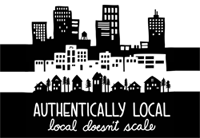This essay, “Ravenna Park (Seattle)“, appears here thanks to HistoryLink.org and author Peter Blecha, under a Creative Commons license.
[If you missed Part 1, you can find it here.]
Ravenna Springs Park
William N. Bell (1817-1887) and his wife Sarah Ann Bell (1815-1856) selected some acreage north of Union Bay that included the lower end of the creek that emerged from the ravine. In the years prior to Bell’s death the couple sold their land and it reportedly passed through several hands until George and Oltilde Dorffel acquired ownership in 1887, the same year they filed paperwork platting it as Ravenna Springs Park — a name inspired by the famously beautiful pine-tree-forested ravine town of Ravenna, Italy. Soon those 40-some springs bubbling from the ground were being touted for their medicinal properties.
The year 1889 saw another couple — William Wirt Beck and his wife Louise Coman Beck — investing in a huge parcel of 400 acres on the north side of Union Bay including the Dorffels’ park. The Becks were an interesting duo: He was a Presbyterian minister from Kentucky (who would later claim a background as a miner). She was an Athens, Georgia, native who had graduated from the Athens Female College and then studied music in the Northeast. She was well equipped to teach music in Seattle.
The Becks were ambitious: They envisioned a whole new town, Ravenna, arising on their land and toward that end they quickly platted out town lots southward from the edge of the park and entered the world of real estate sales. The Becks built a large house (at the northeast corner of NE 57th Street and 26th Avenue NE) on 10 acres that also contained their Seattle Female College.
The college enrolled 40 students for the 1890 school year, and soon included the Seattle Conservatory of Music and Ravenna Seminary. In addition they arranged to have a post office (headed by a Lafayette S. Beck) established and founded the Ravenna Flouring Co. Roper’s Grocery soon joined the hamlet. Best of all, the little town would be serviced at a Ravenna Station (at Blakely Street and 25th Avenue NE) by the Seattle, Lake Shore & Eastern railroad, which passed through the area on its route from downtown Seattle (along today’s Burke-Gilman Trail).
Next week: Rainier Power and Railway Company
______________________
Sources:
W. W. Beck, Ravenna Park — ‘Im Walde,’ (1903), Peter Blecha collection, Seattle; W. W. Beck, Ravenna Park — ‘Im Walde,’ 16-page postcard booklet, undated, in Peter Blecha collection; W. W. Beck, Ravenna Park (ca. 1909), Peter Blecha collection; “Ravenna Park Guide,” brochure, 1909, Peter Blecha collection; “Ravenna Or Big Tree Park: It is Famous = “Nature’s Exposition,” postcard, 1909, Peter Blecha collection; Harvey Manning, Winter Walks and Hikes (Seattle: Mountaineers Books, 2002), 42; Betty McDonald, Anybody Can Do Anything (Philadelphia / New York: J. B. Lippincott Co, 1950), 129-130; Paula Becker, “Time Traveling The Roosevelt District With Betty Macdonald,” Seattlepress.com website accessed July 13, 2010 (http://seattlepress.com/article-9455.html); “One of Ravenna’s Giant Trees Christened ‘Paderewski,'” Interlaken, February 8, 1908, p. 1; Sophie Frye Bass, When Seattle Was A Village (Seattle: Lowman & Hanford Co., 1947), 106-108: David Buerge, “Indian Lake Washington,” Seattle Weekly, August 1-7, 1984; Seattle Polk City Directory (1901-1934); Directory of the National Society of the Daughters of the American Revolution (Washington D.C.: Memorial Continental Hall, 1911), 1340; “Mrs. L. C. Beck Funeral To Be Held Today: Woman Widely Known In Musical and Club Circles Is Mourned By Seattle Friends,” Seattle Post-Intelligencer, July 9, 1928, p. 13; Kate C. Duncan 1001 Curious Things: Tales from Ye Olde Curiosity Shop (Seattle: University of Washington Press, 2000), 73-78; Andrea Casadio, email to Peter Blecha, January 30, 2008; “No Finer Site: The University of Washington’s Early Years On Union Bay,” Web exhibition, University of Washington Libraries website accessed August 19, 2010 (http://lib.washington.edu/exhibits/site/); HistoryLink.org Online Encyclopedia of Washington State History, “Seattle’s Ravenna Park Bridge is constructed in 1913” (by Priscilla Long), and “WPA builds Cowen Park Bridge in Seattle’s Ravenna neighborhood in 1936” (by Priscilla Long), and “John Olmsted arrives in Seattle to design city parks on April 30, 1903” (by David Williams and Walt Crowley), and “David Thomas Denny (1832-1903)” (by David Wilma), http://www.historylink.org/ (accessed August 1, 2010); Esther Campbell, Bagpipes in the Woodwind Section (Seattle: Seattle Symphony Women’s Association, 1978), 9; William Arnold, “The Great Mystery of Ravenna Park,” Seattle Post-Intelligencer, Northwest Today section, December 17, 1972, pp. 8-9; Steve Cronin, “Ravenna Park’s Famous Trees Vanished Furtively,” UW Daily, May 25, 1977, p. 3; James Bush, “Remembering William W. Beck: The Father of Ravenna Park,” The Seattle Sun, August 2003, The Seattle Sun website accessed August 25, 2010 (http://parkprojects.com/2003news/0308aug/hisbeck.html); Mary R. Watson, travel diary (handwritten), 1910, portion accessed on eBay, December 2006, copy in possession of Peter Blecha; Russ Hanbey, “1916 Seattle was a Hotbed of Sin When 2 Officers Were Killed,” The Seattle Times, February 6, 2010 (http://seattletimes.nwsource.com); and Peter Blecha archives.








Stay Connected